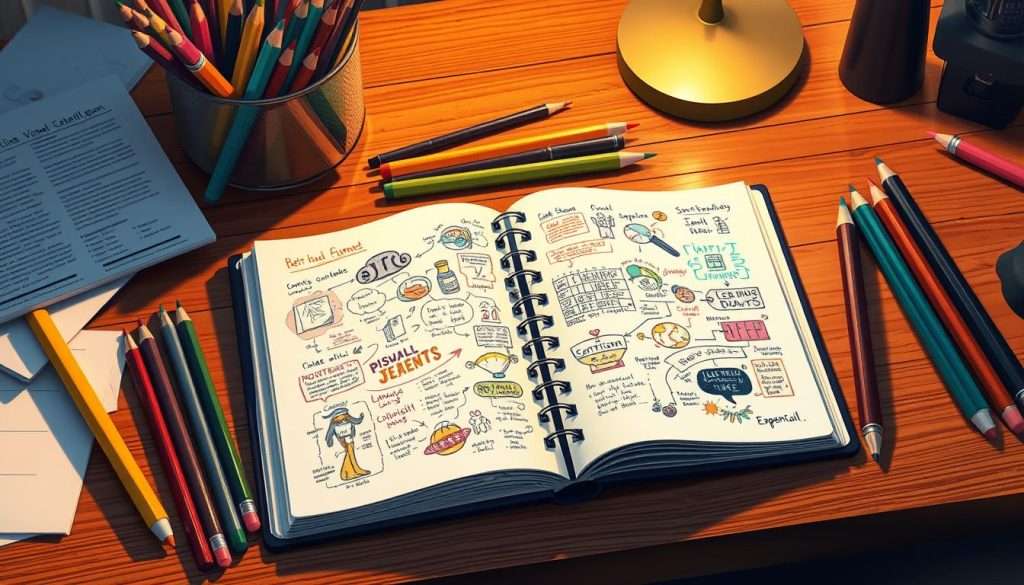“The way to get started is to quit talking and begin doing.” These words by Walt Disney show how to turn dreams into reality. For students, one great way to reach their goals is by journaling for academic success.
Writing down your thoughts and insights in a journal helps you focus on your goals. It also lets you see how far you’ve come. This simple tool can be a big help in getting better grades.
Key Takeaways
- Journaling helps clarify academic objectives.
- It enhances the learning experience.
- Journaling fosters personal growth.
- It aids in tracking progress.
- Journaling is a simple tool for achieving academic excellence.
The Science Behind Journaling and Learning
Journaling is more than just a hobby. It’s a powerful tool that can greatly improve our learning. By writing down our thoughts and experiences, we engage our brains. This strengthens memory, fosters reflection, and deepens understanding.
How Writing Enhances Memory Retention
Writing down information helps us remember it better. Research shows that writing enhances memory by engaging multiple senses. It reinforces neural pathways. When we write, we’re more likely to remember key details because we’ve actively processed the information.
The Cognitive Benefits of Reflection
Journaling encourages reflection, which is key for learning. By reflecting on our experiences, we can identify patterns and make connections. This reflective practice helps us learn from our mistakes and build on our successes.
Research-Backed Evidence on Journaling for Learning
Studies have shown that journaling can improve learning outcomes. For example, a study on students using learning journals found they showed increased metacognition and self-awareness. The table below summarizes some key findings from research on journaling and learning.
| Research Focus | Key Findings |
|---|---|
| Memory Retention | Writing information down enhances recall and retention. |
| Cognitive Reflection | Journaling promotes deeper understanding and connection-making. |
| Learning Outcomes | Students using journals show improved metacognition and self-awareness. |
Journal Your Way to Learn Better: Core Benefits
Journaling is a powerful tool for students and lifelong learners. It offers many cognitive benefits that improve learning. By writing down your thoughts, you’re not just recording info. You’re actively processing and understanding it.
Increased Comprehension and Critical Thinking
Journaling lets you dig deeper into the material you’re studying. Writing down key concepts and your reactions helps you engage with the content. This leads to a deeper understanding.
This process also boosts critical thinking. You learn to evaluate information, spot patterns, and connect different ideas.
Improved Organization of Thoughts and Ideas
A learning journal helps you organize your thoughts and ideas. As you write, you see how different concepts relate. This helps you clarify your thinking.
This organization makes it easier to review material for exams or projects. You can quickly find and reference your notes and insights.
Enhanced Metacognition and Self-Awareness
Journaling about your learning process boosts metacognition. It lets you think about your own thinking. By reflecting on what works best for you and what challenges you face, you can tailor your learning strategies to your needs.
This self-awareness is key for effective learning. It lets you adapt your approach as needed and take charge of your education.
Types of Learning Journals to Consider
There are many types of learning journals, each with its own way to help you learn. By trying out different ones, you can find the perfect fit for your learning style.
Reflective Journals
Reflective journals are for writing down your thoughts and feelings about what you learn. They help you understand your learning better by reflecting on what you’ve learned. Reflective journaling also helps you adjust your learning strategies.
Concept Maps and Visual Journals
Concept maps and visual journals are great for visual learners. They use diagrams and images to show how ideas are connected. This makes complex topics easier to understand.
Question-Based Learning Journals
Question-based journals focus on asking questions and finding answers. They encourage critical thinking and curiosity. This way, you can dive deeper into the subject matter.
Digital vs. Handwritten Journals
The choice between digital and handwritten journals is a personal one. Handwritten journals offer a unique experience, while digital ones are convenient and easy to organize. Think about what works best for you.
| Journal Type | Key Features | Benefits |
|---|---|---|
| Reflective Journals | Recording thoughts and feelings | Develops metacognition, deeper understanding |
| Concept Maps and Visual Journals | Visual representations, diagrams | Enhances understanding of complex topics |
| Question-Based Learning Journals | Inquiry-based, questioning | Fosters critical thinking, curiosity |
Exploring different learning journals can enhance your learning experience. Whether you like writing by hand or using digital tools, the important thing is to make journaling a regular part of your learning.
Setting Up Your Learning Journal
Creating a learning journal that fits your needs is the first step. We’ll show you how to set up your journal for the best results.
Choosing the Right Format and Tools
Choosing the right format and tools for your journal is key. You can pick a traditional notebook or a digital app. Think about what suits your learning style best.
If you learn better with pictures, a journal with lots of space for drawings might be perfect.
Creating an Effective Journal Structure
A good journal structure keeps you organized. You can split your journal into sections for different topics. Or, use a consistent layout for each entry.
Using a template can make this easier. For example, you might have a section for daily reflections, another for setting goals, and a third for summarizing what you learned.
| Section | Purpose | Example |
|---|---|---|
| Daily Reflections | Record daily insights and thoughts | “Today I learned about…” |
| Goal Setting | Outline short-term and long-term goals | “My goal for this week is to…” |
| Key Learnings | Summarize important information | “The main idea I grasped was…” |
Establishing a Consistent Journaling Routine
Being consistent is crucial for journaling benefits. Set aside a specific time each day or week to journal. Experts say a regular routine can greatly improve your learning.
As one expert notes, “Creating a peak state before writing can improve the quality of your journal entries.”
“The key to successful journaling is not in the tool, but in the habit.”
By following these steps, you can make a learning journal that really helps your education.
Step-by-Step Guide to Effective Learning Journaling
We’ll show you how to journal your way to learn better step by step. Learning journaling is a process with several stages. It starts with setting intentions before learning and ends with reflecting on what you’ve learned.
Before Learning: Setting Intentions and Questions
Before you start learning, take a moment to set clear intentions. Ask yourself questions about what you’re about to study. What do you want to achieve? What are your goals? Write down your questions and concerns to focus your learning process.
During Learning: Capturing Key Insights
As you learn, jot down important points and questions that arise. Use your journal to record key concepts, definitions, and examples. This helps you understand the material better.
After Learning: Reflection and Connection-Making
After learning, take time to reflect on what you’ve studied. Ask yourself questions like: What did I learn? How does it relate to what I already know? What connections can I make between this new information and other areas of my knowledge?
Review and Revision Process
Regularly review your journal entries to identify patterns and areas for improvement. Use this information to revise your study plan. Adjust your learning strategy as needed.
| Stage | Actions | Benefits |
|---|---|---|
| Before Learning | Set intentions, ask questions | Focuses learning, clarifies goals |
| During Learning | Capture key insights, record observations | Enhances understanding, retains information |
| After Learning | Reflect, make connections | Deepens understanding, reinforces learning |
| Review and Revision | Review entries, revise study plan | Identifies areas for improvement, adjusts learning strategy |
Powerful Journaling Techniques for Different Learning Styles
There’s a journaling technique for everyone, no matter your learning style. By matching journaling to your style, you can improve learning with journaling. This makes your study time more effective.
Visual Learners: Sketching and Mind Mapping
Visual learners do well with sketching and mind mapping. These methods use pictures to help remember information. Try adding drawings, diagrams, or mind maps to your journal for better learning.

Auditory Learners: Dialogue and Discussion Journaling
Auditory learners benefit from writing down conversations. This can be real or imagined talks about what you’re studying. You can also record yourself explaining topics and write them down. This method strengthens your understanding and memory.
Kinesthetic Learners: Action-Oriented Journaling
Kinesthetic learners learn best by doing. Action-oriented journaling uses physical activities to represent ideas. For example, use colors or symbols to mark important points or create a “scavenger hunt” to find examples in your life.
Reading/Writing Learners: Structured Note-Taking Methods
Reading/writing learners do well with structured note-taking. Methods like the Cornell Notes system or detailed outlines help organize and review material. Try different formats to find what works best for you and boosts your journaling benefits for learning.
Using these journaling techniques can make your study routine more effective. It helps tailor your learning to your unique style and boosts your learning potential.
Overcoming Common Journaling Challenges
Starting your journaling journey can come with challenges. But don’t worry, you’re not alone. Many people face similar issues, and we’re here to guide you through them.
Finding Time for Regular Journaling
Finding time to journal can be tough. Try adding journaling to your daily routine. For example, do it right after studying or before bed. Even a short 10-15 minutes a day can make a big difference.
Dealing with Writer’s Block and Resistance
Writer’s block and resistance are common. To beat them, change your environment or try a new journaling method, like drawing. This can spark your creativity and get you moving again.
Maintaining Motivation and Consistency
To stay motivated, set realistic goals for your journaling. Aim to complete a certain number of entries each week. Celebrating your achievements will keep you motivated and engaged.
Avoiding Perfectionism in Your Journal
Remember, your journal is for your eyes only. Don’t worry about making it perfect. Focus on the journey, not the outcome. This mindset will help you enjoy the process and benefit from journaling.
By facing and solving these common challenges, you can make journaling a valuable part of your learning. Here are some extra tips to keep in mind:
| Challenge | Tip |
|---|---|
| Finding Time | Schedule journaling into your daily planner |
| Writer’s Block | Try freewriting or drawing |
| Maintaining Motivation | Celebrate your journaling milestones |
| Avoiding Perfectionism | Embrace imperfections and focus on the process |
By using these strategies and staying consistent, you can beat common journaling challenges. This will help you enhance your learning through journaling. Stay committed, and you’ll see the positive effects on your learning journey!
Digital Tools and Apps for Learning Journals
Today, we have many digital tools and apps to help us learn through journaling. These tools have features that make journaling better, like note-taking and reflection. They help us organize our thoughts and review our progress.
Note-Taking Apps with Journaling Features
Apps like Evernote and OneNote are great for journaling. They let you create notebooks, tag entries, and even record audio. These apps are perfect for jotting down ideas or for more structured journaling.
Specialized Learning Journal Applications
Apps like Day One and Penzu are made just for learning journals. They have prompts and templates to help you start and keep up with journaling. This makes it easier to reflect on your learning.
Using Templates and Prompts for Digital Journaling
Templates and prompts are key for digital journaling. They give structure and ideas, helping you focus on your learning. Many tools let you customize these, so you can fit your journaling to your needs.

Using these digital tools and apps can make journaling more fun and effective. Whether you’re in school or always learning, adding digital tools to your journaling can really help your learning.
Measuring Your Progress: Tracking Learning Outcomes
Learning through journaling is more than just writing down facts. It’s about seeing how much you’ve grown. As you keep journaling, it’s key to track your progress to reach your learning goals.
Creating Learning Metrics
To track your learning, you need clear metrics. This could be the number of pages read, new concepts learned, or skills mastered. For example, if you’re learning a new language, count the new vocabulary words each week. Setting specific, measurable goals keeps you focused and motivated.
Periodic Review Techniques
It’s important to regularly review your journal. Set aside time each month to look over your entries. Highlight important insights and note areas for improvement. Use reflective questions like “What did I learn this month?” or “What challenges did I face?” to guide your review.
Using Your Journal to Set and Achieve Learning Goals
Your journal is a great tool for setting and reaching learning goals. By regularly checking your progress, you can adjust your goals as needed. Remember,
“The key is not to prioritize what’s on your schedule, but to schedule your priorities.”
Use your journal to focus on your learning goals and stay on track.
By using these strategies, you can measure your progress and reach your learning goals through journaling.
Conclusion: Transform Your Learning Through Consistent Journaling
Journaling is a powerful tool for learning and personal growth. By making journaling a daily habit, you can journal your way to learn better and reach your full potential. It’s great for students and lifelong learners alike, offering better understanding, improved thinking, and self-awareness.
When you improve learning with journaling, you’re doing more than just writing down your thoughts. You’re actively engaging with what you’re learning, making connections, and deepening your understanding. This helps you remember information better and grasp the subject matter more deeply.
So, start your journaling journey today! Try out different methods to see what works for you. Make journaling a regular part of your learning routine. With time and effort, you’ll see how much you can learn and discover.
By sticking with it, you’ll change how you learn and reach your goals. So, grab a notebook, get creative, and start journaling your way to success!

